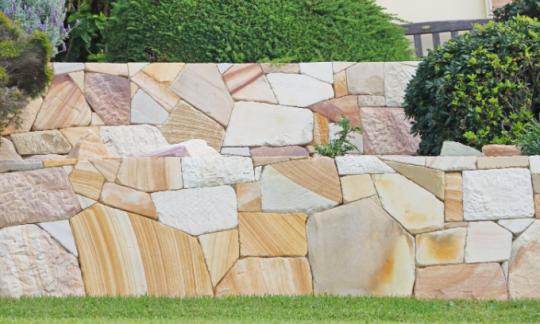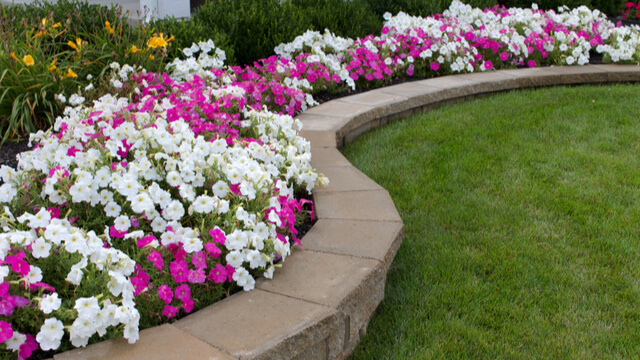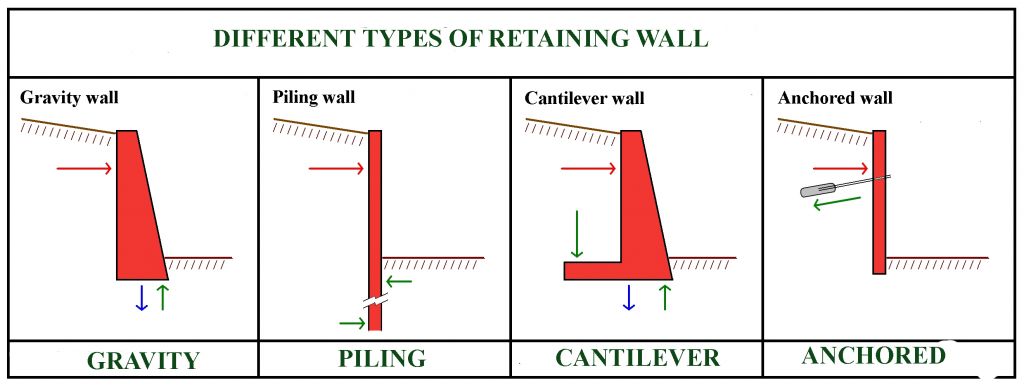How much does a retaining wall cost?
If you’re thinking about adding a retaining wall, you might well be wondering what type you should get, and how much does it cost? We take a look.

If you’re thinking about adding a retaining wall, you might well be wondering what type you should get, and how much does it cost? We take a look.
What is a retaining wall?
A retaining wall is a rigid barrier built for the purpose of preventing soil (or other organic material such as stones) from moving downhill or shifting. Retaining walls can be used to create stepped levels for landscaping purposes, or for practical reasons where soil would otherwise encroach on a road or public footpath.
A retaining wall may be needed in situations where soil has been built up, or a sloped area has been partially excavated and the remaining soil requires support.
How much does a retaining wall cost?
A retaining wall can cost anywhere from $1,000 for a smaller one to more than $10,000 for a larger one, according to trade website hipages. The difference in price can be accounted for in part by the kind of materials you use. For example, hipages estimates that a treated pine retaining wall may cost between $250 to $350 per square metre, while a reinforced concrete block retaining wall could cost anywhere from $400 to $680 per square metre.
Bruce Parke, owner and principal builder of Ascent Design and Build, told Canstar that the question of how much a retaining wall costs is a bit like asking “how long is a piece of string?”.
“Different types of building methods, heights, lengths, and the materials used for construction” will all have an impact on the final cost of your retaining wall. Mr Parke told Canstar that if the ground exceeds a certain height, the wall will need to be designed by a structural engineer to make sure it lasts. This will likely further increase the end cost of your retaining wall. The maximum height to which you can build a retaining wall without it needing to be designed by a structural engineer varies by state/territory and council to council. You’ll require the services of a structural engineer, and potentially need to seek permission for the build from your local council, if the wall is:
- on or near site boundaries where there is a risk of damage to the adjoining property
- 1 metre or more in height.
However, you will find that in some areas, such as NSW, the NT and WA, the council regulations are stricter with the height limit. In the ACT, regulations covering retaining walls are more complex than a simple height maximum or boundary positioning. If you live in the ACT, whether you require development approval and a structural engineer to design your retaining wall will depending on several factors, including:
- the type of retaining wall you’re building (fill, cut-in or a combination)
- where it sits in relation to the boundary
- the surrounding building or structure
- the height of the wall at its lowest point and highest point.
Hipages advises that the fees charged by a structural engineer will depend on the size of your property. In general, you might expect to pay around $300 to $500 for a small property, $500 to $700 for a medium-sized one and $700 to $1000 or more for a larger property, or one with more complex terrain. If you’re not sure whether you’ll need to engage the services of a structural engineer for your retaining wall, you can contact your local council. It will generally be able to advise you of the relevant regulations and bylaws.

What kind of retaining wall do I need?
The retaining wall that best suits your needs will depend on several factors, including the wall’s purpose, what it’ll be retaining, the soil the base will sit on and its location. Here’s a list of different types of retaining walls to give you an idea:
- Gravity retaining walls, which rely solely on their mass to withstand the pressure of the soil behind them. These are typically built using stone, brick or concrete, and are suitable for areas that allow for a wide base in which soil is the only material being retained.
- Cantilevered retaining walls, which are generally made of steel, reinforced concrete or masonry that has been poured and set in place. They are usually shaped like an upside-down T or L, with the footing of the wall set underground and providing additional support against the pressure of the soil being retained.
- Sheet pile, or piling, retaining walls, which are long, vertically set beams or wooden planks that have approximately one third of their length buried into the ground. Taller sheet pile retaining walls or bases with poor soil conditions may require additional bracing or anchoring
- Anchored retaining walls, which are secured at one or more points by cables anchored in the soil or rock sitting behind the wall. This method can also be used to provide additional support to other wall types and often used for taller or structurally thinner walls.

When choosing which type of retaining wall to go with, it’s worth considering what it will be used for and what it will look like. It may also be worth consulting with a professional landscaper or builder in order to determine which type of retaining wall is best suited for your circumstances and desired goals. Another factor which may influence your decision is the varying sustainability of different types of retaining walls and the materials required to build them.
If you’re looking for stylistic inspiration, you could start by taking a look at some of our ideas for different types of retaining walls.
Does a retaining wall require maintenance?
The ongoing maintenance requirements of a retaining wall will generally depend on the materials it is made from, and how it was constructed.
For wooden retaining walls, Mr Parke recommends that you use “something like an H4 timber, which is a treated timber”, that will have some degree of resistance against rot and wear. However, he did note that even these types of treated timbers “do have a shorter lifespan than something like galvanised steel posts or concrete.”
A retaining wall built with adequate backfill (gravel or a similar substance placed behind a wall for drainage purposes) will generally last much longer than one without any built-in drainage or backfill, regardless of the material(s) used. According to Baines Masonry, a retaining wall built without adequate drainage may collapse after heavy rain, due to the added pressure of rainwater collecting behind the wall.
Who is responsible for a retaining wall that straddles two or more properties?
While the laws regarding retaining wall disputes vary by state and territory, the South Australia Legal Services Commission advises that as a general rule, each owner is responsible for retaining the portion of earth that is altered on their property.
If you’re looking to have a retaining wall built, it may be worth ensuring that it won’t encroach on a neighbour’s property, in order to avoid any potential disputes regarding future maintenance.
What should I consider before installing a retaining wall in my garden?
Mr Parke says that if you’re going to try to build your own retaining wall, you need to do your homework. “You really need to know what you’re doing if you’re going to build a wall, otherwise you’ll end up with something that’s got a very short lifespan.” He also noted that when it comes to retaining walls, “you get what you pay for”. Large rocks or stones will be more expensive than any other material used to build a material wall, but they’ll also last the longest, he explained.
How can I pay for my retaining wall?
You’ve got a few options when it comes to financing any sort of home improvement, including paying out of pocket, refinancing your home loan, or taking out a personal loan.
You may want to obtain a quote for your retaining wall before deciding which form of finance is most appropriate for your personal circumstances.If you need to borrow money to fund the job, be sure to pay close attention to factors such as the interest rate you’re charged by the lender, any fees that apply and whether you will be able to afford the repayments.
The comparison rate for all home loans and loans secured against real property are based on secured credit of $150,000 and a term of 25 years.
^WARNING: This comparison rate is true only for the examples given and may not include all fees and charges. Different terms, fees or other loan amounts might result in a different comparison rate.

Up to $4,000 when you take out a IMB home loan. Minimum loan amounts and LVR restrictions apply. Offer available until further notice. See provider website for full details. Exclusions, terms and conditions apply.
 Owner occupied
Owner occupied
 20% min deposit
20% min deposit
 Redraw facility
Redraw facility
 Owner occupied
Owner occupied
 10% min deposit
10% min deposit
 Redraw facility
Redraw facility
 Owner occupied
Owner occupied
 20% min deposit
20% min deposit
 Redraw facility
Redraw facility
 Owner occupied
Owner occupied
 30% min deposit
30% min deposit
 Redraw facility
Redraw facility
 Owner occupied
Owner occupied
 30% min deposit
30% min deposit
 Redraw facility
Redraw facility
Canstar may earn a fee for referrals from its website tables, and from Sponsorship or Promotion of certain products. Fees payable by product providers for referrals and Sponsorship or Promotion may vary between providers, website position, and revenue model. Sponsorship or Promotion fees may be higher than referral fees. Sponsored or Promoted products are clearly disclosed as such on website pages. They may appear in a number of areas of the website such as in comparison tables, on hub pages and in articles. Sponsored or Promoted products may be displayed in a fixed position in a table, regardless of the product’s rating, price or other attributes. The table position of a Sponsored or Promoted product does not indicate any ranking or rating by Canstar. For more information please see How We Get Paid.
Main image source: Douglas Cliff/Shutterstock.com.
This article was reviewed by our Content Lead Mandy Beaumont and Content Producer Karen Yang before it was updated, as part of our fact-checking process.

Alasdair Duncan is Canstar's Deputy Finance Editor, specialising in home loans, property and lifestyle topics. He has written more than 500 articles for Canstar and his work is widely referenced by other publishers and media outlets, including Yahoo Finance, The New Daily, The Motley Fool and Sky News. He has featured as a guest author for property website homely.com.au.
In his more than 15 years working in the media, Alasdair has written for a broad range of publications. Before joining Canstar, he was a News Editor at Pedestrian.TV, part of Australia’s leading youth media group. His work has also appeared on ABC News, Junkee, Rolling Stone, Kotaku, the Sydney Star Observer and The Brag. He has a Bachelor of Laws (Honours) and a Bachelor of Arts with a major in Journalism from the University of Queensland.
When he is not writing about finance for Canstar, Alasdair can probably be found at the beach with his two dogs or listening to podcasts about pop music. You can follow Alasdair on LinkedIn.
- What is a retaining wall?
- How much does a retaining wall cost?
- What kind of retaining wall do I need?
- Does a retaining wall require maintenance?
- Who is responsible for a retaining wall that straddles two or more properties?
- What should I consider before installing a retaining wall in my garden?
- How can I pay for my retaining wall?
The comparison rate for all home loans and loans secured against real property are based on secured credit of $150,000 and a term of 25 years.
^WARNING: This comparison rate is true only for the examples given and may not include all fees and charges. Different terms, fees or other loan amounts might result in a different comparison rate.
 Owner occupied
Owner occupied
 20% min deposit
20% min deposit
 Redraw facility
Redraw facility
Try our Home Loans comparison tool to instantly compare Canstar expert rated options.
The comparison rate for all home loans and loans secured against real property are based on secured credit of $150,000 and a term of 25 years.
^WARNING: This comparison rate is true only for the examples given and may not include all fees and charges. Different terms, fees or other loan amounts might result in a different comparison rate.






